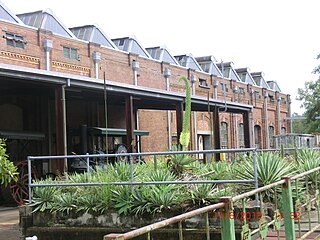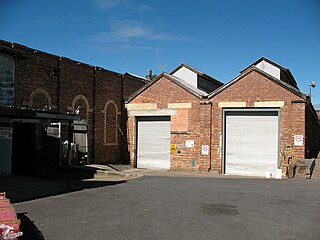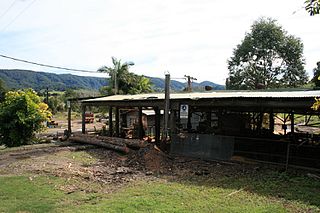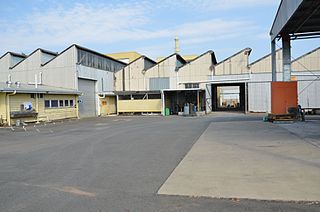
A sawmill or lumber mill is a facility where logs are cut into lumber. Modern sawmills use a motorized saw to cut logs lengthwise to make long pieces, and crosswise to length depending on standard or custom sizes. The "portable" sawmill is simple to operate. The log lies flat on a steel bed, and the motorized saw cuts the log horizontally along the length of the bed, by the operator manually pushing the saw. The most basic kind of sawmill consists of a chainsaw and a customized jig, with similar horizontal operation.

Grandchester is a rural town and locality in the City of Ipswich, Queensland, Australia. In the 2021 census, the locality of Grandchester had a population of 467 people.

Mount Crosby pumping station is a heritage-listed pumping station and weir at Stumers Road, Mount Crosby, City of Brisbane, Queensland, Australia. It is located on the Brisbane River and extends into Chuwar on the other side of the river. The facility supplies water to Brisbane and nearby cities and towns within the SEQ Water Grid. It was originally designed by Charles H McLay and built from 1891 to 1892. The historic parts of the facility were added to the Queensland Heritage Register on 25 October 2019. It is also listed on the Brisbane Heritage Register, together with numerous associated facilities which were not included in the state heritage listing.

A log pond is a small natural lake or reservoir used for storage of wooden logs in readiness for milling at a sawmill. Although some mill ponds served this purpose for water-powered sawmills, steam-powered sawmills used log ponds for transportation of logs near the mill; and did not require the elevation drop of watermill reservoirs.

The Queensland Museum Rail Workshops is a railway museum in Ipswich, Queensland, located within the former North Ipswich Railway Workshops and tells the story of more than 150 years of railways in Queensland. Exhibits are spread out across a number of the complex's original buildings housing a collection of historic steam and diesel locomotives and other rolling stock that operated on Queensland Railways, as well as general interest exhibits and ones tailored specifically for children.

Murphys Creek Railway Complex is a heritage-listed railway yard on the Main Line railway at Odin Street, Murphys Creek, Queensland, Australia. It was built from 1921 to c. 1949. It is also known as Murphys Creek Locomotive Water Tank & Tower. It was added to the Queensland Heritage Register on 24 September 1999.

Lahey's Canungra Sawmill is a heritage-listed former sawmill at 10-26 Finch Road, Canungra, Scenic Rim Region, Queensland, Australia. It was built in 1884. It was added to the Queensland Heritage Register on 6 March 2009.

Queensland Woollen Manufacturing Company mill is a heritage-listed mill at 42 & 42B The Terrace, North Ipswich, City of Ipswich, Queensland, Australia. It is also known as Australian Fabric Manufacturers Ltd and Boral Hancock Plywood. It was added to the Queensland Heritage Register on 19 September 2008.

North Ipswich Railway Workshops is a heritage-listed former Australian railway workshop at North Street, North Ipswich, Queensland. It was built from 1878 to 1980s. It is also known as the Workshops Rail Museum. It was added to the Queensland Heritage Register on 21 April 1997.

Jimna Single Men's Barracks is a heritage-listed workers' housing at 4 Tip Road, Jimna, Somerset Region, Queensland, Australia. It was built in 1930s. It was added to the Queensland Heritage Register on 27 November 2008.

Conondale Timbers sawmill is a heritage-listed sawmill at Aherns Road, Conondale, Sunshine Coast Region, Queensland, Australia. It was built in the 1930s by M R Hornibrook Ltd. It is also known as Conondale Timbers mill workers cottages. It was added to the Queensland Heritage Register on 27 November 2008.

Cooroy Lower Mill Site Kiln is a heritage-listed kiln at Lower Mill Road, Cooroy, Shire of Noosa, Queensland, Australia. It was built in 1950s. It was added to the Queensland Heritage Register on 11 December 2008.

Kin Kin Sawmill is a heritage-listed sawmill at 1 Sister Tree Creek Road, Kin Kin, Shire of Noosa, Queensland, Australia. It was built in 1940s. It was added to the Queensland Heritage Register on 27 November 2008.

Mill Point Settlement Site is a heritage-listed former settlement at Elanda Point at Lake Cootharaba in Como, Shire of Noosa, Queensland, Australia. It was built from c. 1869 to the 1940s. It was added to the Queensland Heritage Register on 6 April 2005.

Elgin Vale Sawmill is a heritage-listed sawmill at Manumbar Road, Elgin Vale, Gympie Region, Queensland, Australia. It was built in 1944 for T H Spencer by Wilson Hart Limited. It was added to the Queensland Heritage Register on 17 September 2010.

Rockhampton Railway Workshops is a heritage-listed railway workshop at 380 Bolsover Street, Depot Hill, Rockhampton Region, Queensland, Australia. It was built from 1915 to 1953. It is also known as Rockhampton Roundhouse. It was added to the Queensland Heritage Register on 21 August 1992.

Cairns Plywood Pty Ltd Sawmill Complex is a heritage-listed sawmill at 25–33 Eacham Road, Yungaburra, Tablelands Region, Queensland, Australia. It was built from 1910 to the 1980s. It is also known as Cairns Plywood Limited, Eacham Sawmills, and Williamson Brothers Sawmill. It was added to the Queensland Heritage Register on 21 October 1992.

Tyrconnel Mine and Battery is a heritage-listed gold mine between Kingsborough and Thornborough, Shire of Mareeba, Queensland, Australia. It was built from 1876 to 1980s. It was added to the Queensland Heritage Register on 21 October 1992.

Johnston's Sawmill Steam Plant is a heritage-listed former sawmill at corner of Santowski Crescent and the Peninsular Development Road, Mount Molloy, Shire of Mareeba, Queensland, Australia. It was built in 1914 and operated until 1963 when it burned down for the last time. It was added to the Queensland Heritage Register on 15 July 2011.
The Hokianga Sawmill Company wharf was built in 1878 at Kohukohu as the first stage of the company's sawmilling operations there. It was constructed by Auckland shipwright William Lowe from totara and heart kauri with local Maori engaged to do the labour. The sawmill was later taken over in 1888 by the Kauri Timber Company as part of its nationwide purchasing of sawmilling companies and assets. The wharf and mill site was later used for the manufacture of butter boxes from 1933 until 1937. The wharf was decommissioned in 1938. The former wharf is on the Heritage New Zealand list of historic places as a Category 2 site, List No: 3947 and was registered on 6 September 1984.























